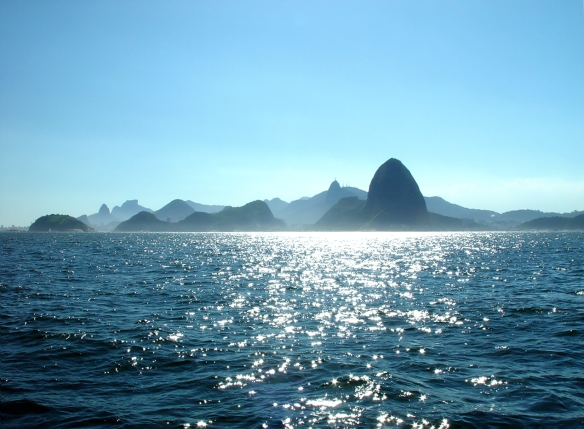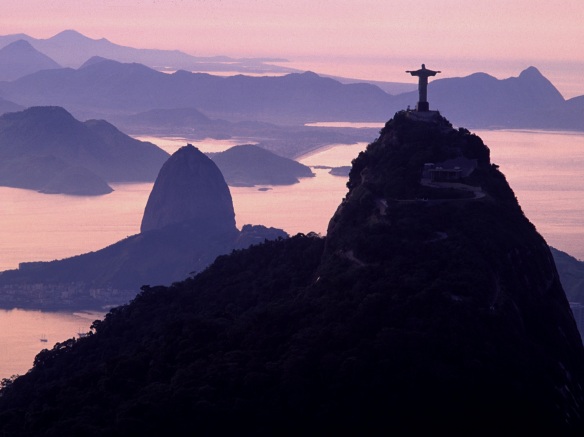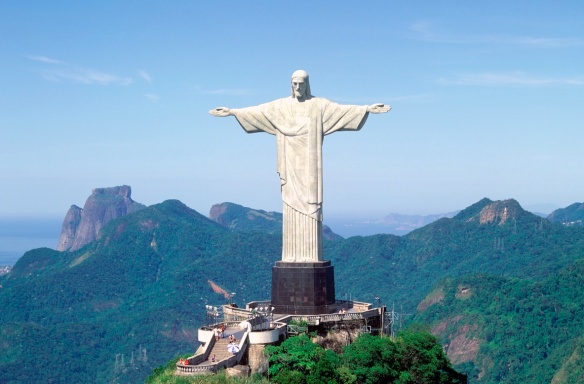Affectionately known as Cidade Maravilhosa – the Marvellous City – Rio de Janeiro does not disappoint. Whatever your expectations Rio is more beautiful, breathtaking and vibrant than any words or photos can do justice. Don’t take our word for it, go and see for yourself why UNESCO awarded the city World Heritage status in 2012 based on its iconic setting and landscape.
For a much more complete and comprehensive guide to the city and state of Rio de Janeiro visit our sister site Rio: The Guide
 Lying on latitude 22º 54’ 24” south and longitude 43º10’ 21” west, on the Tropic of Capricorn, metropolitan Rio is home to nearly 12 million Cariocas, as the local residents are known. Covering an area of 1,171 km2, Rio is, after São Paulo, Brazil’s second largest city.
Lying on latitude 22º 54’ 24” south and longitude 43º10’ 21” west, on the Tropic of Capricorn, metropolitan Rio is home to nearly 12 million Cariocas, as the local residents are known. Covering an area of 1,171 km2, Rio is, after São Paulo, Brazil’s second largest city.
Rio, which hosted the finals of the 2013 Confedertions Cup, the 2014 FIFA World Cup and the 2016 Olympic and Parlaympic games, is both a major cosmopolitan city and a tropical resort. As a major city it has all you might expect. First class restaurants, fashionable bars, sophisticated and cutting edge night clubs, musical extravaganzas and festivals, theatres, cinemas, museums, art galleries, world class sport, designer stores and stylish shopping centres.
As a resort, Rio has miles and miles of golden beaches (over 56 miles to be exact), great weather for most of the year, accommodation to appeal to almost every taste and budget, folklore, typical foods and music, sightseeing, and that feeling that you have really travelled somewhere special and different.
None of this takes into account the overall beauty of the city that has made Rio globally famous and a much sought after leisure destination. It was also one of the reasons UNESCO awarded the city World Heritage status on 1 July 2012.
 Rio is broken by the mountains in to two fairly distinctive zones, north and south. The north zone, zona norte, is where the bulk of Rio’s industrial activity and heavy industry is located, around which the main areas of poor and lower middle class housing are to be found. The famous south zone, zona sul, on the other hand, houses the more expensive residential and cultural areas as well as all the major hotels. The buffer between north and south is the city centre, Centro, the commercial, banking and historic heart of Rio, that has an increasingly active cultural and entertainment scene . Visitors only really need to be concerned with the zona sul, unless they have to visit a factory or office located up in the zona norte. The only other reasons to visit the north zone is to visit the international airport or the Maracanã and Engenhão stadiums.
Rio is broken by the mountains in to two fairly distinctive zones, north and south. The north zone, zona norte, is where the bulk of Rio’s industrial activity and heavy industry is located, around which the main areas of poor and lower middle class housing are to be found. The famous south zone, zona sul, on the other hand, houses the more expensive residential and cultural areas as well as all the major hotels. The buffer between north and south is the city centre, Centro, the commercial, banking and historic heart of Rio, that has an increasingly active cultural and entertainment scene . Visitors only really need to be concerned with the zona sul, unless they have to visit a factory or office located up in the zona norte. The only other reasons to visit the north zone is to visit the international airport or the Maracanã and Engenhão stadiums.
It is the mountains and sea, and their juxtaposition, that that have given the world’s largest tropical city its beauty, and it is these same topographical features that have dictated how Rio has grown and spread out along the coast and inland since being first discovered by Europeans in the early 16th century.
 Many of Rio’s attractions have links to the mountains and sea and are household names, and not just in Brazil. There is Corcovado Mountain and the Statue of Christ the Redeemer, considered one of the modern seven wonders of the world, from where visitors can look down on Sugar Loaf Mountain, another global landmark, and the bay of Rio, a bay so large that the first explorers assumed it was the mouth of a great river and called it River of January or Rio de Janeiro.
Many of Rio’s attractions have links to the mountains and sea and are household names, and not just in Brazil. There is Corcovado Mountain and the Statue of Christ the Redeemer, considered one of the modern seven wonders of the world, from where visitors can look down on Sugar Loaf Mountain, another global landmark, and the bay of Rio, a bay so large that the first explorers assumed it was the mouth of a great river and called it River of January or Rio de Janeiro.
From Copacabana to Ipanema, the beaches are equally well known, and in between the original suburbs whose names are now synonymous with the city’s football clubs, teams such as Flamengo and Botafogo. The big soccer games are still played at the Maracanã Stadium which when it opened for the 1950 World Cup could handle crowds in excess of 200,000. Sixty years on the stadium is still one of the largest in the world, seating 76,000, and hosted the final of the 2013 Confederation’s Cup, the final of the 2014 World Cup, and the opening and closing ceremonies of the 2016 Olympics.
 Rio made full use of its natural setting during the Olympic games. Copacabana Beach hosted the beach volleyball, triathlon and long distance swimming, while the yachtsmen and women had the backdrop of Sugar Loaf and Guanabara Bay to compete with, and the rowers the Lagoa Rodrigo de Freitas and Corcovado. Even the Sambódromo, home to the carnival parades, hosted the marathon and archery, while Barra da Tijuca was the site of the Olympic Village and a number of Olympic facilities including the golf and tennis.
Rio made full use of its natural setting during the Olympic games. Copacabana Beach hosted the beach volleyball, triathlon and long distance swimming, while the yachtsmen and women had the backdrop of Sugar Loaf and Guanabara Bay to compete with, and the rowers the Lagoa Rodrigo de Freitas and Corcovado. Even the Sambódromo, home to the carnival parades, hosted the marathon and archery, while Barra da Tijuca was the site of the Olympic Village and a number of Olympic facilities including the golf and tennis.
 While sport put Rio firmly in the global spotlight in recent years, it is also a cultural city. It is the birthplace of both bossa nova and samba, and its musicians remain at the forefront of Brazilian musical trends. The country’s main TV network, Globo, is based in Rio, as are much of the country’s film industry and South America’s main film festival, Festival do Rio. Rio is also home to South America’s largest music festival, Rock in Rio. The city’s carnival is, of course, the world’s biggest and most famous, and the celebrations to see in the New Year on Copacabana Beach are one of the most spectacular to take place anywhere on the planet.
While sport put Rio firmly in the global spotlight in recent years, it is also a cultural city. It is the birthplace of both bossa nova and samba, and its musicians remain at the forefront of Brazilian musical trends. The country’s main TV network, Globo, is based in Rio, as are much of the country’s film industry and South America’s main film festival, Festival do Rio. Rio is also home to South America’s largest music festival, Rock in Rio. The city’s carnival is, of course, the world’s biggest and most famous, and the celebrations to see in the New Year on Copacabana Beach are one of the most spectacular to take place anywhere on the planet.
Rio can be visited in its own right, but it can also act as your doorway to visiting the rest of Brazil, be that you are on business or pleasure, with daily flights linking Europe and North America to Rio de Janeiro and beyond. But do make sure that when you do visit Rio, you leave enough time to do the city justice.
For an “At-Glance Guide” to Rio de Janeiro click here
On from the city of Rio to the state of Rio
Visitors who want to concentrate on Rio de Janeiro, and not take extra internal domestic flights, have plenty of options in close proximity to the city.
They range from Rio’s fashionable weekend playgrounds of Búzios and the Sun Coast, to the colonial masterpiece that is Paraty, and the lush verdant greenery and tropical islands of the Green Coast. Another option, and a fascinating day trip, is a drive of 40 miles (66km) into the mountains above Rio to visit the Imperial City of Petrópolis where the Summer Palace of the emperors and the Imperial Museum can be found amongst other attractions.
Rio the Guide
 Due to popular demand we launched the web site Rio the Guide which offers a full and comprehensive guide to the city based on the legendary Insider’s Guide to Rio de Janeiro. For many years the biggest selling guide book to the city, but until this web update out of print since 1995. To go to our sister site CLICK HERE
Due to popular demand we launched the web site Rio the Guide which offers a full and comprehensive guide to the city based on the legendary Insider’s Guide to Rio de Janeiro. For many years the biggest selling guide book to the city, but until this web update out of print since 1995. To go to our sister site CLICK HERE
_________________________________________________________________
Copyright © 1984-2024
Christopher Pickard – Brazil the Guide – Critical Divide
All rights reserved – Todos os direitos reservados
criticaldivide.com – braziltheguide.com

